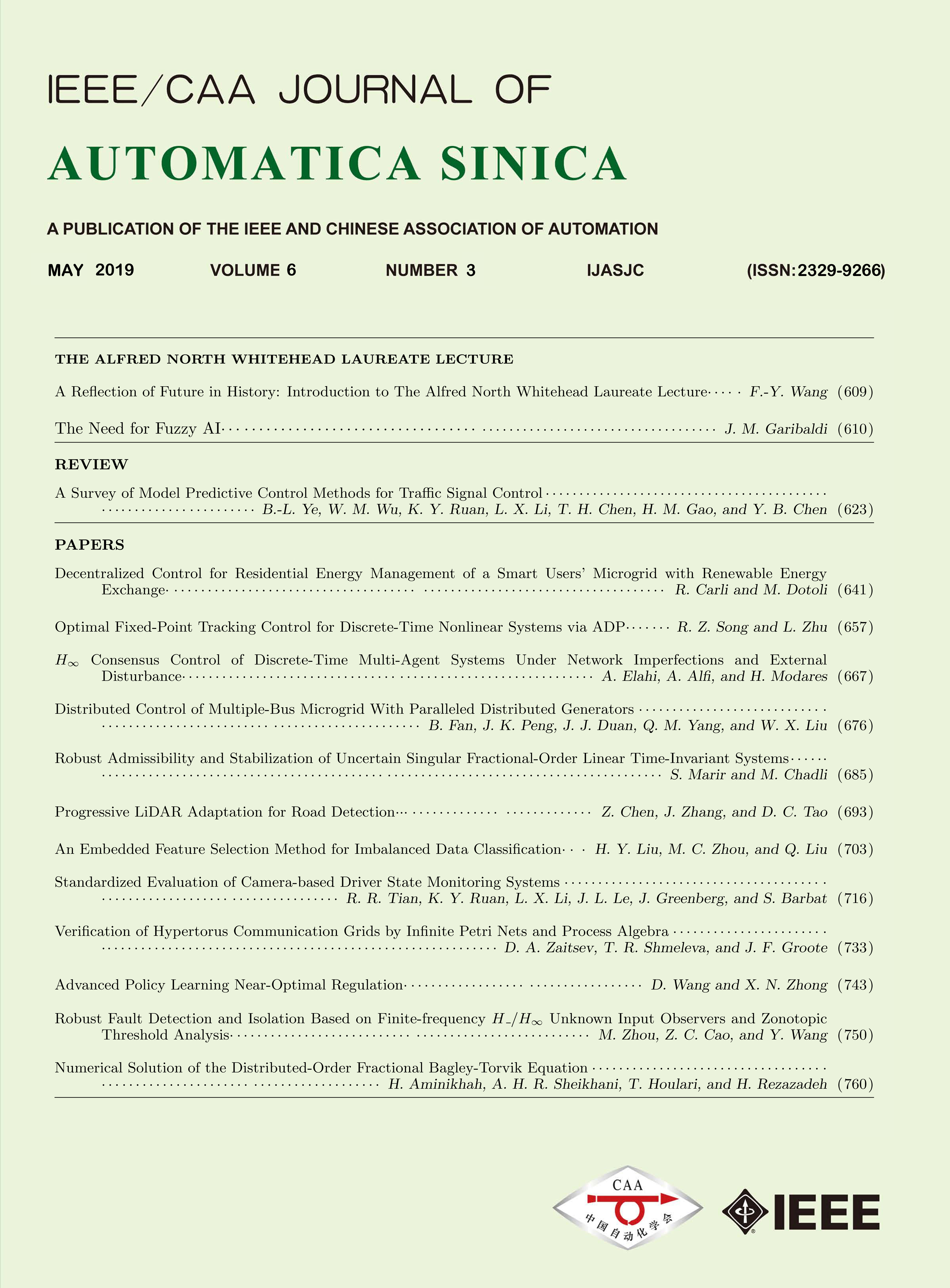 Volume 6
Issue 3
Volume 6
Issue 3
IEEE/CAA Journal of Automatica Sinica
| Citation: | Satish Kumar, Rajesh Devaraj and Arnab Sarkar, "A Hybrid Offline-Online Approach to Adaptive Downlink Resource Allocation Over LTE," IEEE/CAA J. Autom. Sinica, vol. 6, no. 3, pp. 766-777, May 2019. doi: 10.1109/JAS.2018.7511105 |

| [1] |
C. V. N. Index, "Global mobile data traffic forecast update, 2015-2020, " White Paper, Feb. 3, 2016.[Online]. Available: http://goo.gl/ylTuVx.
|
| [2] |
C. Cox, An Introduction to LTE: LTE, LTE-Advanced, SAE and 4G Mobile Communications. London, UK: John Wiley & Sons, 2012.
|
| [3] |
G. Piro, L. A. Grieco, G. Boggia, R. Fortuna, and P. Camarda, "Two-level downlink scheduling for real-time multimedia services in LTE networks, " IEEE Trans. Multimedia, vol. 13, no. 5, pp. 1052-1065, Oct. 2011. http://dl.acm.org/citation.cfm?id=2334941
|
| [4] |
J. T. S. Avocanh, M. Abdennebi, and J. Ben-Othman, "A new two-level scheduling algorithm for the downlink of LTE networks, " in Proc. IEEE Global Communications Conf. (GLOBECOM), Atlanta, GA, USA, 2013, pp. 4519-4523.
|
| [5] |
A. Pokhariyal, K. I. Pedersen, G. Monghal, I. Z. Kovacs, C. Rosa, T. E. Kolding, and P. E. Mogensen, "HARQ aware frequency domain packet scheduler with different degrees of fairness for the UTRAN long term evolution, " in Proc. 65th Vehicular Technology Conf.-VTC2007-Spring, Dublin, Ireland, 2007, pp. 2761-2765.
|
| [6] |
S. Kumar, A. Sarkar, S. Sriram, and A. Sur, "A three level LTE downlink scheduling framework for RT VBR traffic, " Comput. Netw., vol. 91, pp. 654-674, Nov. 2015.
|
| [7] |
S. Kumar, S. Sriram, A. Sarkar, and A. Sur, "A three level adaptive video streaming framework over LTE, " in Proc. IEEE Int. Conf. Systems, Man, and Cybernetics (SMC), Budapest, Hungary, 2016, pp. 2442-2447.
|
| [8] |
R. Nossenson, "Long-term evolution network architecture, " in IEEE Int. Conf. Microwaves, Communications, Antennas and Electronics Systems, Tel Aviv, Israel, 2009, pp. 1-4.
|
| [9] |
G. Piro, L. A. Grieco, G. Boggia, F. Capozzi, and P. Camarda, "Simulating LTE cellular systems: An open-source framework, " IEEE Trans. Veh. Technol., vol. 60, no. 2, pp. 498-513, Feb. 2011.
|
| [10] |
3GPP, "Tech. Specif. Group Radio Access Network; Conveying MCS and TB Size via PDCCH, " 3GPP TSG-RAN WG1 R1-081483.
|
| [11] |
C. G. Cassandras and S. Lafortune, Introduction to Discrete Event Systems. 2nd ed. New York, USA: Springer, 2008.
|
| [12] |
R. Devaraj, A. Sarkar, and S. Biswas, "Real-time scheduling of non-preemptive sporadic tasks on uniprocessor systems using supervisory control of timed DES, " in Proc. American Control Conference (ACC), Seattle, WA, USA, 2017, pp. 3212-3217.
|
| [13] |
M. Agarwal, S. Biswas, and S. Nandi, "Discrete event system framework for fault diagnosis with measurement inconsistency: case study of rogue dhcp attack, " IEEE/CAA J. Autom. Sinica, doi: 10.1109/JAS.2017.7510379, 2019.
|
| [14] |
M. Agarwal, S. Purwar, S. Biswas, and S. Nandi, "Intrusion detection system for PS-Poll DoS attack in 802.11 networks using real time discrete event system, " IEEE/CAA J. Autom. Sinica, vol. 4, no. 4, pp. 792-808, Nov. 2017.
|
| [15] |
R. Devaraj, A. Sarkar, and S. Biswas, "Fault-tolerant preemptive aperiodic RT scheduling by supervisory control of TDES on multiprocessors, " ACM Trans. Embedded Comput. Syst., vol. 16, no. 3, pp. 87, Jul. 2017.
|
| [16] |
A. S. Tanenbaum and H. Bos, Modern Operating Systems. 4th ed. London, UK: Prentice Hall Press, 2014.
|
| [17] |
V. Vukadinovic and G. Karlsson, "Video streaming performance under proportional fair scheduling, " IEEE J. Sel. Areas Commun., vol. 28, no. 3, pp. 399-408, Apr. 2010. http://ieeexplore.ieee.org/xpls/icp.jsp?arnumber=5434405
|
| [18] |
F. Capozzi, G. Piro, L. A. Grieco, G. Boggia, and P. Camarda, "Downlink packet scheduling in LTE cellular networks: Key design issues and a survey, " IEEE Commun. Surv. Tutor., vol. 15, no. 2, pp. 678-700, Apr.-Jun. 2013.
|
| [19] |
S. Shakkottai and A. L. Stolyar, "Scheduling for multiple flows sharing a time-varying channel: the exponential rule, " American Mathematical Society Translations, Series, vol. 2, pp. 2002, 2000.
|
| [20] |
B. Sadiq, S. J. Baek, and G. de Veciana, "Delay-optimal opportunistic scheduling and approximations: the log rule, " IEEE/ACM Trans. Netw., vol. 19, no. 2, pp. 405-418, Apr. 2011. http://ieeexplore.ieee.org/xpls/icp.jsp?arnumber=5062088
|
| [21] |
H. Chen, P. Y. Sun, and K. H. Guo, "Constrained h-infinity control of active suspensions: an LMI approach, " in Proc. Int. Conf. Control and Automation, Xiamen, China, 2002, pp. 157.
|
| [22] |
W. C. Sun, H. J. Gao, and O. Kaynak, "Vibration isolation for active suspensions with performance constraints and actuator saturation, " IEEE/ASME Trans. Mechatron., vol. 20, no. 2, pp. 675-683, Apr. 2015.
|
| [23] |
W. C. Sun, H. H. Pan, and H. J. Gao, "Filter-based adaptive vibration control for active vehicle suspensions with electrohydraulic actuators, " IEEE Trans. Veh. Technol., vol. 65, no. 6, pp. 4619-4626, Jun. 2016.
|
| [24] |
M. M. S. Pasand and M. Montazeri, "Structural properties, LQG control and scheduling of a networked control system with bandwidth limitations and transmission delays, " IEEE/CAA J. Autom. Sinica, doi: 10.1109/JAS.2017.75103732017, 2017.
|
| [25] |
C. Bettstetter, "Mobility modeling in wireless networks: Categorization, smooth movement, and border effects, " ACM SIGMOBILE Mob. Comput. Commun. Rev., vol. 5, no. 3, pp. 55-66, Jul. 2001.
|